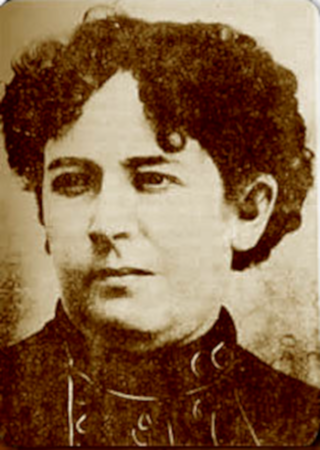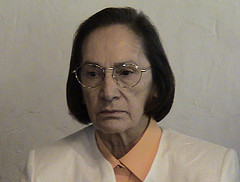Related Research Articles

Dolores Jiménez y Muro was a Mexican schoolteacher and revolutionary. A native of Aguascalientes, Aguascalientes, Mexico, she rose to prominence during the Mexican Revolution as a Socialist activist and reformer and as a supporter and associate of General Emiliano Zapata.

Juana Belén Gutiérrez de Mendoza was a Mexican journalist, feminist, professor, and activist. She was an author of radical feminist literature and contributed to leftist newspapers including El Diario del Hogar and El Hijo del Ahuizote. Considered a prominent female writer and participant in the Mexican Revolution, she was outspoken in her criticism of the Catholic church and Porfiriato through her newspaper Vesper.
Feminism in Mexico is the philosophy and activity aimed at creating, defining, and protecting political, economic, cultural, and social equality in women's rights and opportunities for Mexican women. Rooted in liberal thought, the term feminism came into use in late nineteenth-century Mexico and in common parlance among elites in the early twentieth century. The history of feminism in Mexico can be divided chronologically into a number of periods with issues. For the conquest and colonial eras, some figures have been re-evaluated in the modern era and can be considered part of the history of feminism in Mexico. At the time of independence in the early nineteenth century, there were demands that women be defined as citizens. The late nineteenth century saw the explicit development of feminism as an ideology. Liberalism advocated secular education for both girls and boys as part of a modernizing project, and women entered the workforce as teachers. Those women were at the forefront of feminism, forming groups that critiqued existing treatment of women in the realms of legal status, access to education, and economic and political power. More scholarly attention is focused on the Revolutionary period (1915–1925), although women's citizenship and legal equality were not explicitly issues for which the revolution was fought. The Second Wave and the post-1990 period have also received considerable scholarly attention. Feminism has advocated for the equality of men and women, but middle-class women took the lead in the formation of feminist groups, the founding of journals to disseminate feminist thought, and other forms of activism. Working-class women in the modern era could advocate within their unions or political parties. The participants in the Mexico 68 clashes who went on to form that generation's feminist movement were predominantly students and educators. The advisers who established themselves within the unions after the 1985 earthquakes were educated women who understood the legal and political aspects of organized labor. What they realized was that to form a sustained movement and attract working-class women to what was a largely middle-class movement, they needed to utilize workers' expertise and knowledge of their jobs to meld a practical, working system. In the 1990s, women's rights in indigenous communities became an issue, particularly in the Zapatista uprising in Chiapas. Reproductive rights remain an ongoing issue, particularly since 1991, when the Catholic Church in Mexico was no longer constitutionally restricted from being involved in politics.

Esther Chapa Tijerina was a Mexican medical surgeon, educator, writer, feminist, suffragist, trade unionist, and women's and children's rights activist. In her medical practice she specialized in clinical analysis and microbiology, and she taught microbiology at the National Autonomous University of Mexico.

Amalia González Caballero de Castillo Ledón was a Mexican diplomat, cabinet minister, minister plenipotentiary, writer, and the first female member of a presidential cabinet. She distinguished herself for fighting for women rights including her efforts to secure women's voting rights in 1952.
Gerónima Sofía Villa de Buentello was a Mexican feminist who worked in the first wave of the suffrage movement in Mexico and was one of the first women to analyze the legal equality of men and women before the law. She founded the Women of the [Hispanic] race and led the faction of more moderate feminists in the 1920s in Mexico.
Natividad Herminia Álvarez Herrera (1888–1955) was a Mexican Revolutionary War veteran, propagandist and personal tutor and governess for the children of Venustiano Carranza. She was the founder of the Confederación Femenil Mexicana.

Elena Arizmendi Mejía was a Mexican feminist who established the Neutral White Cross to care for casualties of the Mexican Revolution that the Red Cross would not aid. Participating in the first wave of Mexican feminism, she established two international women's rights organizations: the "Mujeres de la Raza" and the International League of Iberian and Latin American Women.
Mercedes Sandoval de Hempel was a Paraguayan lawyer and feminist. She was one of the leading proponents of women's suffrage in the country, drafting the Anteproyecto de Ley de Reforma Parcial del Código Civil. In 1992, the amendment of the Paraguayan Civil Code finally recognized equality between men and women. The wording of Article 1 of Law 704/61 was simple: “Reconócese a la mujer los mismos derechos y obligaciones políticos que al hombre.”
Olga Núñez Abaunza was the first female Nicaraguan lawyer and first female notary. She was the first woman to serve in a Ministerial capacity and the First woman Deputy to serve in the National Assembly of Nicaragua. She was an ardent feminist, attending feminist conferences, forming a feminine wing of the liberal party, and running for office on a feminist platform.
Carmen Sánchez de Bustamante Calvo was a Bolivian woman's rights advocate and the first Bolivian woman to serve on the OAS's Inter-American Commission of Women. She also served on the organizing committee from the Women's International League for Peace and Freedom for the Primer Congreso Interamericano de Mujeres. A Bolivian women's rights organization, the Carmen Sánchez Bustamante Foundation was named in recognition of her work to promote women's rights.

The Inter-American Commission of Women, abbreviated CIM, is an organization that falls within the Organization of American States. It was established in 1928 by the Sixth Pan-American Conference and is composed of one female representative from each Republic in the Union. In 1938, the CIM was made a permanent organization, with the goal of studying and addressing women's issues in the Americas.
Graciela Quan Valenzuela was a Guatemalan lawyer and activist. She campaigned for women's suffrage, writing a draft proposal for Guatemala's enfranchisement law. She was also a social worker, adviser to the President of Guatemala, delegate to the United Nations and the President of the Inter-American Commission of Women.
The Unión de Mujeres Americanas was founded in 1934 by Mexican women's rights activist and suffragette, Margarita Robles de Mendoza. The purpose of the organization was to develop ties between women in the region to fight for the civic and political rights of women throughout the Americas and improve women's social and economic situations. She served as first chair along with an international board which initially had representatives from Cuba, the Dominican Republic, Peru and Venezuela. The headquarters of the organization is in New York City, but there are branches of affiliates in almost every country of the Western Hemisphere.

Esperanza Brito de Martí was a Mexican journalist, feminist and reproductive rights activist. She was the director of Fem magazine for nearly 30 years and wrote as a correspondent for several newspapers and magazines. Her journalism was honored with the National Journalism Prize "Juan Ignacio Castorena y Visúa". She was an advocate for both contraception and abortion rights. Through her many activities, she co-founded the Coalición de Mujeres Feministas, the Movimiento Nacional de Mujeres and pressed for the founding of the first Rape Crisis and Guidance Center (Coapevi), first agency for dealing specifically with sexual crimes, first Center for Domestic and Sexual Violence (NOTIFY). In 1998, the first Center for Support of Women which was named after her was opened.
Lidia Fernández Jiménez was a Costa Rican suffragist and feminist active between 1920 and 1940 in the struggle for women's right to vote.

Marta Vergara Varas was a Chilean author, editor, journalist and women's rights activist. Introduced to international feminism in 1930, she became instrumental in the development of the Inter-American Commission of Women (CIM) helping gather documentation on laws which effected women's nationality. She pushed Doris Stevens to broaden the scope of international feminism to include working women's issues in the quest for equality. A founding member of the Pro-Emancipation Movement of Chilean Women, she was editor of its monthly bulletin La Mujer Nueva. When she was ousted from the Communist Party she moved to Europe and worked as a journalist during the war. At war's end, she returned to Washington, D.C., and worked at the CIM continuing to press for women's suffrage and equality, before returning to Chile, where she resumed her writing career.
The struggle for women's right to vote in Mexico dates back to the nineteenth century, with the right being achieved in 1953.

Gloria Menéndez Mina was a Guatemalan writer and women's rights activist who was involved in the women's suffrage movement in Guatemala. One of the first women to participate in journalism in the country, she directed the magazines Mujer and Azul. In her later career, she served as a press attaché in Mexico and was known for her book, Francisco Javier Mina, héroe de México y España.
María Elena Urritia was a Mexican journalist, writer, researcher, and activist. She played a key role in starting the feminist magazine Fem. She was the fourth of six children born to conservative Catholic parents.
References
- 1 2 3 4 5 6 7 8 9 Jaiven, Ana Lau (January 2009). "Entre ambas fronteras: tras la igualdad de derechos para las mujeres". Política y cultura (in Spanish) (31). Mexico City, Mexico: SciElo, Universidad Autónoma Metropolitana. ISSN 0188-7742 . Retrieved 30 July 2015.
- 1 2 3 4 5 Mitchell, Stephanie Evaline; Schell, Patience A. (2007). The women's revolution in Mexico, 1910-1953. Lanham [Md.]: Rowman & Littlefield Pub. p. 82. ISBN 978-0-742-53731-6.
- ↑ Seminar on Feminism and Culture in Latin America (1990). Women, culture, and politics in Latin America. Berkeley, California: University of California Press. p. 17. ISBN 978-0-520-90907-6 . Retrieved 29 July 2015.
- ↑ Ganzert, Frederic W. (27 December 1936). "Get Half a Loaf". Salt Lake City, Utah: The Salt Lake Tribune. p. C5. Retrieved 31 July 2015– via Newspapers.com.

- ↑ Schechter, Patricia A. (2012). Exploring the decolonial imaginary four transnational lives (1st ed.). New York, NY: Palgrave Macmillan. p. 212. ISBN 978-1-137-01284-5.
- ↑ "Schechter (2012)", p 113
- ↑ "Mexican Feminist". San Bernardino, California: The San Bernardino County Sun. 20 July 1936. p. 5. Retrieved 31 July 2015– via Newspapers.com.

- ↑ "Cardenas in Sympathy". San Bernardino, California: The San Bernardino County Sun. 1 February 1936. p. 4. Retrieved 31 July 2015– via Newspapers.com.

- ↑ "Mitchell/Schell (2007)", p 78
- ↑ Olcott, Jocelyn H.; Vaughan, Mary Kay (2006). Sex in Revolution: Gender, Politics, and Power in Modern Mexico. Durham, North Carolina: Duke University Press. p. 223. ISBN 978-0-822-33899-4.
- ↑ Bauermeister, Jennifer L. (December 1999). "The Involvement of Women in Mexican Politics and Economics" (PDF). Pullman, Washington: Washington State University. pp. 4–5. Retrieved 30 July 2015.
- ↑ Viniegra, Angel (3 October 1940). "Women Renew Mexican Drive for Franchise". Kingsport, Tennessee: Kingsport Times. UPI. p. 5. Retrieved 30 July 2015– via Newspapers.com.

- ↑ "Mitchell/Schell (2007)", p 82
- ↑ "Symposium to Hear Latin American War Role". Brooklyn, New York: The Brooklyn Daily Eagle. 11 February 1943. p. 4. Retrieved 31 July 2015– via Newspapers.com.

- ↑ Threlkeld, Megan (2014). Pan American Women: U.S. Internationalists and Revolutionary Mexico (PDF). Philadelphia, Pennsylvania: University of Pennsylvania Press. pp. 191–196. ISBN 978-0-812-29002-8 . Retrieved 3 August 2015– via Project MUSE.